
|
You entered: pleiades
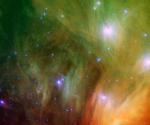 Seven Dusty Sisters
Seven Dusty Sisters
13.04.2007
Hurtling through a cosmic dust cloud a mere 400 light-years away, the lovely Pleiades or Seven Sisters star cluster is well-known in astronomical images for its striking blue reflection nebulae. At visible wavelengths...
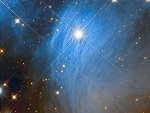 Meropes Reflection Nebula
Meropes Reflection Nebula
15.02.2012
Reflection nebulas reflect light from a nearby star. Many small carbon grains in the nebula reflect the light. The blue color typical of reflection nebula is caused by blue light being more efficiently scattered by the carbon dust than red light.
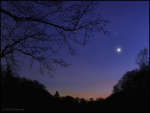 Venus in the West
Venus in the West
10.04.2015
In the coming days, Venus shines near the western horizon at sunset. To find Earth's sister planet in twilight skies just look for the brilliant evening star. Tonight very close to the Pleiades...
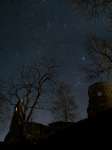 Starry Night Castle
Starry Night Castle
18.01.2008
The tantalizing Pleiades star cluster seems to lie just beyond the trees above a dark castle tower in this dramatic view of The World at Night. Recorded earlier this month, the starry sky also...
 Seven Dusty Sisters
Seven Dusty Sisters
27.05.2018
Is this really the famous Pleaides star cluster? Known for its iconic blue stars, the Pleaides is shown here in infrared light where the surrounding dust outshines the stars. Here three infrared colors have been mapped into visual colors (R=24, G=12, B=4.6 microns).
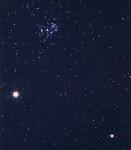 Jupiter, Saturn and Messier 45
Jupiter, Saturn and Messier 45
21.03.2001
Brilliant Venus falls out of the evening sky as March ends, but Jupiter and Saturn remain well up above the western horizon. Jupiter blazes forth above and to the left of a slightly fainter Saturn in this telephoto picture taken on January 19th.
 Two Comets and a Star Cluster
Two Comets and a Star Cluster
1.10.2017
Two unusual spots are on the move near the famous Pleiades star cluster. Shifting only a small amount per night, these spots are actually comets in our nearby Solar System that by chance wandered into the field of the light-years distant stars.
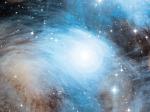 The Merope Reflection Nebula
The Merope Reflection Nebula
11.06.2007
Reflection nebulas reflect light from a nearby star. Many small carbon grains in the nebula reflect the light. The blue color typical of reflection nebula is caused by blue light being more efficiently scattered by the carbon dust than red light.
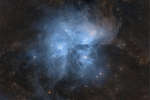 Messier 45: The Daughters of Atlas and Pleione
Messier 45: The Daughters of Atlas and Pleione
4.01.2023
Hurtling through a cosmic dust cloud a mere 400 light-years away, the lovely Pleiades or Seven Sisters open star cluster is well-known for its striking blue reflection nebulae. It lies in the night sky toward the constellation Taurus and the Orion Arm of our Milky Way galaxy.
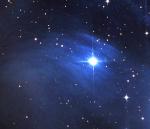 Reflection Nebula NGC 1435
Reflection Nebula NGC 1435
28.02.1999
Reflection nebulae reflect light from a nearby star. Many small carbon grains in the nebula reflect the light. The blue color typical of reflection nebula is caused by blue light being more efficiently scattered by the carbon dust than red light.
|
January February March April |
|||||||||||||||||||||||||||||||||||||||||||||||||